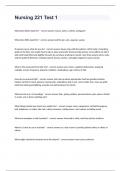Exam (elaborations)
Nursing 221 Test 1 Herzing University - Questions with complete solution
- Course
- Institution
Nursing 221 Test 1 Herzing University - Questions with complete solution Nursing 221 Test 1 What does RACE stand for? - correct answer rescue, alarm, confine, extinguish What does PASS stand for? - correct answer pull the pin, aim, squeeze, sweep If seizures occur what do you do? - corre...
[Show more]



